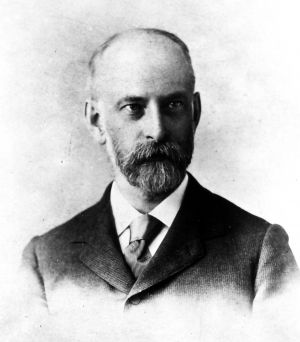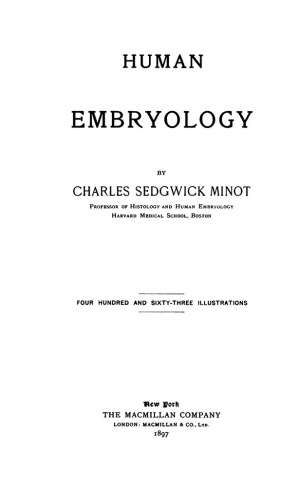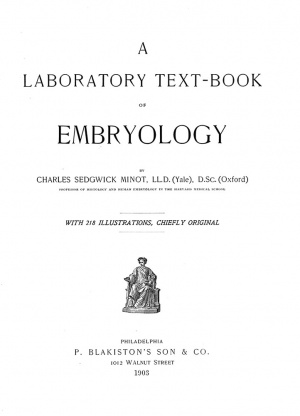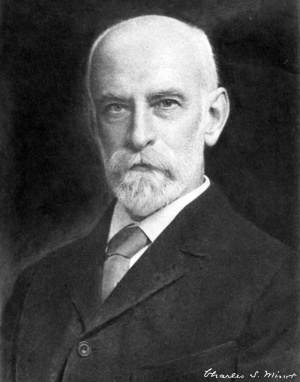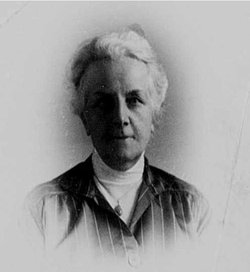Embryology History - Charles Minot
Introduction
Charles Sedgwick Minot (1852–1914) was an American anatomist and embryologist. In 1883 he was appointed instructor in histology and embryology in the Harvard Medical School.
His embryological collection, The Harvard Embryological Collection (the Minot Collection) now forms part of the Carnegie collection. He was an editorial board member of The American Journal of Anatomy.
Minot memorials by Charles W. Eliot and W. T. Councilman.
| Embryologists: William Hunter | Wilhelm Roux | Caspar Wolff | Wilhelm His | Oscar Hertwig | Julius Kollmann | Hans Spemann | Francis Balfour | Charles Minot | Ambrosius Hubrecht | Charles Bardeen | Franz Keibel | Franklin Mall | Florence Sabin | George Streeter | George Corner | James Hill | Jan Florian | Thomas Bryce | Thomas Morgan | Ernest Frazer | Francisco Orts-Llorca | José Doménech Mateu | Frederic Lewis | Arthur Meyer | Robert Meyer | Erich Blechschmidt | Klaus Hinrichsen | Hideo Nishimura | Arthur Hertig | John Rock | Viktor Hamburger | Mary Lyon | Nicole Le Douarin | Robert Winston | Fabiola Müller | Ronan O'Rahilly | Robert Edwards | John Gurdon | Shinya Yamanaka | Embryology History | Category:People | ||
|
The Harvard Embryological Collection
Minot CS. The Harvard embryological collection. (1905) J Med Res. Aug;13(5):499-522.PMID 19971684 | PDF
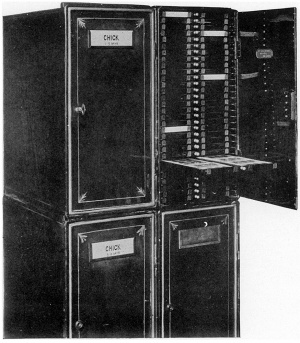
Harvard collection storage cabinet[1] |
The collection of serial sections of embryos in the Embryological Laboratory of the Medical School has now grown to sufficient size to render clear the scope of the collection, and to enable us to form some estimate of its usefulness in facilitating study and promoting research. At this date it comprises nine hundred and thirty-seven series. The plan which has been followed was drawn up in 1895, and its execution was begun in January, I896, and since that time work on the enlargemeent of the collection has been unremitting, although, of course, many other duties had to receive attention in the laboratory; the preparation of serial sections being only one of the things to be attended to in the course of the regular work. Our means have not hitherto permitted us to employ assistance which should be devoted exclusively to the development of the collection. In spite of these difficulties, however, the actual achievement may, I think, be regarded as encouraging.
|
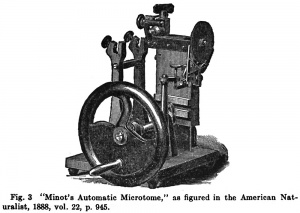
|
- Links: Harvard Collection
Human Embryology (1897)
Minot CS. Human Embryology. (1897) London: The Macmillan Company.
|
A Laboratory Text-Book Of Embryology (1903)
Minot CS. A Laboratory Text-Book Of Embryology. (1903) Philadelphia:P. Blakiston's Son & Co.
|
|
Normal Plates of the Development of the Rabbit 1905
Minot CS. and Taylor E. Normal Plates of the Development of the Rabbit Embryo (Lepus cuniculus). Vol. 5 in series by Keibel F. Normal plates of the development of vertebrates (Normentafeln zur Entwicklungsgeschichte der Wirbelthiere) Fisher, Jena., Germany.

|
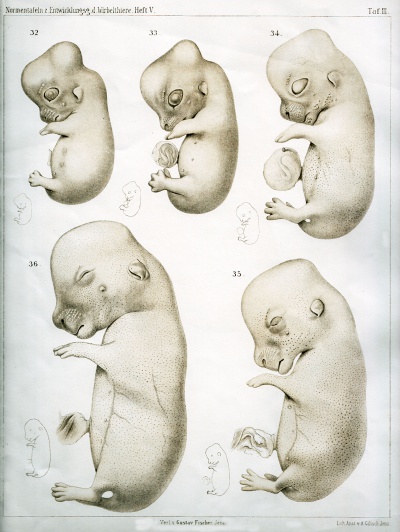
|
| Plate 2 | Plate 3 |
Charles Sedgwick Minot Memorial
- Address before the Boston Society of Natural History at a memorial meeting held on March 17, 1915.[2]
I wish to dwell in this paper not on the scientific attainments and successes of Charles Sedgwick Minot, but on the mental and moral qualities which his career illustrates and which made him what he was.
Young Minot did not follow the traditional course of education for the son of a well-to-do Boston lawyer. He did not go to Harvard College, but to the Massachusetts Institute of Technology and his first degree, that of bachelor of science, was obtained from that technical school. His major subject in that school was not the common one of engineering, but the uncommon one of natural history. He later pursued his studies in this unusual subject at Leipzig, Wiirzburg and Paris. Then, returning to Boston, he took the degree of doctor of science at Harvard University in 1878, again in the subject of natural history. His education, therefore, showed his determination in following his bent, and his independence in parting from his boyhood associates and his family's habitual practise in regard to the education of sons.
Then, as now, the only career open to students of natural history was a professorship in some branch of that subject, but this was not the career to which Minot looked forward. His studies were all histological and embryological, and their most practical and useful applications seemed to him to lie somewhere in the field of medical science and education.
Two years later he accepted two appointments in connection with Harvard University ; one an appointment as lecturer in embryology in the medical school; the other an appointment as instructor in oral pathology and surgery in the dental school.
These appointments were procured for him with some difficulty, for he was not a doctor of medicine, and it was an unwelcome idea for the medical faculty that any instruction whatever should be given in the medical school by a person who had never taken the degree of doctor of medicine.
He accepted both these appointments with alacrity, although dentistry was not recognized then as a medical specialty, and immediately showed himself to be a competent lecturer and laboratory teacher in subjects which depended on the facile use of the microscope by both teacher and students. The place he took in the dental school had, just previously, been filled by Arthur Tracy Cabot, who had shown by his acceptance of that appointment his sympathy with the efforts of the university to lift and improve the dental school and the dental profession, and his prophetic belief that the relations between dentistry and clinical medicine were to become much more intimate than they had been.
In 1883, Minot was advanced to the position of instructor in histology and embryology, and this subject was given a satisfactory place in the curriculum of the medical school. There was still resistance to the appointment of a teacher who did not hold the degree of doctor of medicine, but Minot had, in three years, proved not only that he was the vigorous teacher, but that he had business qualities which would make him a remarkably good director of a laboratory for the instruction of medical students. He devised an excellent method of buying microscopes for the whole class and loaning them to students for a term fee which was sufficient to keep every microscope in repair and in time to repay their whole cost.
He studied every detail of the furniture and fittings of a medical laboratory and decided on the shape and the size of the desk room which each student needed. He made highly intelligent use of the card catalogue for his growing collection of embryological specimens, for his library and for his student records. He became expert in everything relating to the conduct of a laboratory and set a good example to all the other teachers who were conducting laboratories in the medical school. As the school was then in the process of changing from a school in which the lecture predominated to a school in which the laboratory predominated, Minot became more and more useful to the medical school as a whole.
In the year 1887, it was possible to appoint him to an assistant professorship of histology and embryology. At the expiration of the usual term for an assistant professor (five years) he was made professor of histology and human embryology, and in this appointment, with its new title, Minot 's special subjects and his high merits both in teaching and in research were fully recognized.
Between 1881 and 1883, the medical faculty planned and erected a new building for its own use on Boylston Street, at the corner of Exeter Street — a building in which laboratories occupied a large part. Minot obtained for his courses an excellent laboratory of his own planning. There, in twenty years, he built up his unique embryological collection; a monument to his insight, skill, industry and power of inspiring others with his own zeal. In less than twenty years this building became inadequate for the best development of the medical school, and the new buildings of 1905 began to be planned. The fundamental consideration in planning and constructing the new buildings was to adapt them thoroughly to the new method of instruction in medicine— a method which relied chiefly on individual instruction and laboratory work. Minot's careful study of the best laboratory conditions for small sections, in welllighted and well-ventilated rooms, with a desk for each student, was taken up again and contributed much to the final success of the architect's plans. The accommodations for the department of histology and human embryology conformed to Minot's conception of the present and future needs of his department and served as a type for the laboratories of other departments in the school.
It became possible to enlarge the number of teachers employed in the department, and its intimate connection with the teaching of anatomy was recognized. When Dr. Thomas Dwight, professor of anatomy since 1883, died in 1911, the school was fully prepared to recognize the fact that anatomy and histology belonged together. In the mean time, the James Stillman professorship of comparative anatomy had been endowed and to that Professor Minot had been transferred in 1905. No professor of anatomy was appointed to succeed Dr. Dwight, but in 1912 Minot was made director of the anatomical laboratories in the Harvard Medical School. This action of the faculty and the corporation crowned Minot 's professional career as a student and teacher of natural history, applied in medical education. By clear merit he had made his way and the way of his department in the school and without a medical degree had become the head of anatomical teaching in a medical school. Under him in the anatomical department were two assistant professors, one of whom was called assistant professor of anatomy and the other of histology. Fourteen other teachers were employed in the department of anatomy and histology, three of whom bore the title of histology and embryology, Minot 's original subjects in the medical school.
Minot's advance through the medical school was not facilitated by a yielding or compromising disposition, or any practise of that sort on his part. On the contrary, he pursued his ends with clear-sighted intensity and indomitable persistence ; suavity and geniality were not his leading characteristics in discussion or competition and he often found it hard to see that his opponent had some reason on his side. Like most independent and resolute thinkers, he had confidence in the soundness of his own reasoning, and in the justice of the cause or movement he had espoused.
He was upright in every sense of that word. His loyalty was firm and undeviating, whether to an ideal or a person or an institution, and affection and devotion, once planted in his breast, held for good and all.
His book on "Human Embryology" published in 1892 made him famous throughout the learned world, so that he was elected to learned societies in Great Britain, Italy, France, Germany and Belgium; as well as to all appropriate American societies. He also received honorary degrees from the universities of St. Andrew's (Scotland), Oxford (England), Toronto (Canada), and Yale. He enjoyed calmly and simply the honours thus paid to his scientific attainments and services by well informed and impartial judges.
In 1913" he was Harvard exchange professor at the universities of Berlin and Vienna, where he gladly availed himself of many opportunities to expound to his German colleagues the advances in natural history, including medicine, which were due to American investigators.
His hair and beard were now whitening, but he felt all the ardors of youth, and among them, fervid patriotism. In scientific investigation Minot showed imagination, penetration and eagerness, but also caution. In 1907 he gave a course of lectures at the Lowell Institute on "Age, Growth and Death" and made them the basis of a book published the following year. For him, the subject meant cell metamorphosis, with which he had been familiar through all his studies in histology and embryology, but what he sought in this subject of "Age, Growth and Death" was a scientific solution of the problem of old age which should have — I quote his words— "in our minds, the character of a safe, sound and trustworthy biological conclusion." He ventured to think that some contemporary students of the phenomena of longevity had failed to exercise sufficient caution in forming their conclusions. Nevertheless, Minot was a scientific optimist; full of hope for perpetual progress and for useful results at many stages of the long way. These characteristics appeared clearly in the following passage, taken from the first lecture of that course at the Lowell Institute :
I hope before I finish to convince you that we are already able to establish certain significant generalizations as to what is essential in the change from youth to old age, and that in consequence of these generalizations now possible to us new problems present themselves to our minds, which we hope really to be able to solve, and that in the solving of them we shall gain a sort of knowledge which is likely to be not only highly interesting to the scientific biologist, but also to prove in the end of great praetieal value.
There spoke the cautious, modest, hopeful scientist, expectant of good. Such is the faith which inspires the devoted lives of scientific inquirers.
Charles W. Eliot
Charles Sedgwick Minot (1852-1914)
National Academy of Sciences of The United States of America - Biographical Memoirs Part Of Volume IX Biographical Memoir of Charles Sedgwick Minot (1852-1914) Fellow in Class II, Section 3, 1882. National Academy of Sciences of The United States of America - Biographical Memoirs Part Of Volume IX Biographical Memoir of Charles Sedgwick Minot (1852-1914) Fellow in Class II, Section 3, 1882.
Charles Sedgwick Minot was born in Boston, December 23, 1852. His parental home, five miles from Boston, and comprising about thirty acres, stood on the edge of the forest area which then stretched from Forest Hills on the north to the Blue Hills and the Great Ponds in Canton and Braintree on the south. The region even now, as seen from the summit of Blue Hill, is largely a low forest, most of it of second and third growth, with areas of cleared land in which are small towns and villages, with farm lands about them. There are interspersed fine villas inhabitated by wealthy Bostonians, and most of the Forest is now included in the Metropolitan Park system and will be preserved. There are extensive low marshy flats, subject to overflow, along the Neponset River, and included in the forest there are large areas of swamp. Fine trees, elms, oaks, ash, beeches and pines abound in the region, but the trees in the forest areas are generally small. The flora and fauna are abundant and diversified. It is a stimulating region even now to a boy who has the capacity to see things and joy in seeing the wonder and beauty in nature. In Minot's boyhood the region must have been much wilder and hence more interesting than now. In such surroundings the boy grew up and early acquired the love of nature, the capacity of seeing, and the scientific curiosity to find out the meaning of the things he saw, which distinguished the life of the man.
He was a member of a large and well known family, with inherited wealth and distinguished in useful service. The usual course for a boy in his social class would have been to go through Harvard College and it is uncertain why he went to the Institute of Technology instead. The Institute had but recently been founded, it was just entering upon the great career which it has attained, and had the glamour of a new enterprise. At that time Minot could not have obtained in the Institute much stimulation in the study of natural science which from boyhood he had enthusiastically followed. He had already, at the age of sixteen, made his appearance in scientific literature by the description of the male of Hesperia Metea, a small butterfly captured in Dorchester and of especial interest because only the female of the species had been previously found. He derived probably a great stimulus from the meetings of the Boston Society of Natural History, which he regularly attended and took part in the discussions. He graduated from the Institute in 1872, at the age of twenty. The influence of the training he acquired at the Institute can be seen in his later life by the interest he had in mechanics and which led him to devise a number of laboratory instruments, among them the well known Minot microtome, which were characterized by simplicity of structure and admirable adaptation to the end in view. The micro-tome made it possible to cut thin serial sections of organs and is now, with slight and unimportant modifications, the instrument almost universally used for this purpose.
After graduating from the Institute he studied for a time with Agassiz, but he found the most congenial atmosphere in the laboratory of his friend, Henry Bowditch, who had returned from Europe in 1871 and established the first physiological laboratory in this country. Minot was his first research student and found in the older man both a congenial friend and an enthusiastic teacher. The period was one in which teaching in medical science with the laboratory as a basis was just beginning in this country. Previous to this the only laboratories, if they could be called such, in connection with medical schools were the dissecting rooms, and in Bowditch's laboratory the torch of science which was kindled in the ardent flame of the physiological laboratory in Leipzig burned brightly. His work with Bowditch turned his mind into channels which he afterwards followed, his early interest in form and structure being never lost, although modified by his study in physiology of the phenomena of life. In 1874 he published, in collaboration with Bowditch, a paper on the influence of anaesthetics on the vasomotor system, and in 1876 a short paper on transfusion and autotransfusion.
He went to Europe in 1873, working first at Leipzig with Ludwig in physiology, then at Paris with Ranvier in histology, and at Wiirzburg with Semper in zoology. His was not the common fleeting visit to these laboratories, but in each his stay was sufficiently long for him to become acquainted not only with the laboratory work and methods, but with the ideals which directed it. While at Leipzig under Ludwig's direction, he studied the production of CO2 in the active and resting muscle. He returned to America in 1876 and conducted an extensive series of experiments on tetanus, which was published in 1878, and in the same year received from Harvard University the degree of Doctor of Science.
In 1880 he received his first academic appointment, that of Lecturer on Embryology in the Harvard Medical School, and Instructor in Oral Pathology and Surgery in the Dental School. At that time it was unusual anywhere that instruction in a medical subject should be given by a person who had never taken the degree of Doctor of Medicine, and the appointment of Minot was a distinct break in the academic tradition. The appointment was due to the far-sighted intelligence of Mr. Eliot, who recognized the ability of Minot and desired for the Medical School the influence which a man trained in the traditions of pure science would exert on both the faculty and the students. The appointment was not welcomed in the faculty, and for a long time Minot undoubtedly suffered from his supposed deficiencies. The idea that a man teaching in a medical school should have some knowledge of disease and be able to give an added interest to the subject he teaches by pointing out the practical application of what is taught is not altogether a faulty one, for medicine, certainly for the majority of those entering into it is an art, but like all other arts founded on science. In 1883 he was advanced to the position of Instructor in Histology and Embryology, and this subject was given a satisfactory place in the curriculum, though it was a number of years before laboratory instruction in this subject was made obligatory and a definite part of the course. In the year 1887 he was advanced to the position of Assistant Professor. After the usual term of five years he was made Professor of Histology and Embryology, and when the James Stillman Professorship of Comparative Anatomy was founded he was transferred to that position. Upon the death of Doctor Dwight, in 1911, the subjects of Anatomy and Histology were placed together, and in 1912 he was made Director of the combined laboratories.
As a member of the faculty Minot was always outspoken, clear and logical. He never sought to obtain any end by suavity or the claims of friendship. His arguments were always keen, definitely to the point in view which was strongly presented, sometimes even too much so. There is apt to be some suspicion in the minds of men when a policy advocated is too clearly presented; it is not flattering to those holding the opposite view. The general discussions in medical faculties do not suffer from clear and logical statement, and Minot's presentation of a subject was in marked contrast to that usually heard. While it often took a long time for men to agree with him, and he usually obtained what was desired, there was never a suspicion that the ends in view were personal and selfish. His active support could always be obtained for any measure looking to the betterment of instruction and the advance of scientific interest.
He was in all respects an admirable teacher; as a lecturer simple and clear, interesting, often enlivening the subject by shafts of keen humor, and in the laboratory stimulating, always insisting that the students should cultivate the faculties of independent observation and judgment. Minot was the first to introduce into the medical schools of the country the laboratory method of student instruction, and the way is never easy for the pioneer. It was a method new to the students, for the men entering the medical schools seem to acquire neither in the home, nor in the schools, nor in the colleges sufficient training in the methods of science. Minot lived to see the modest beginning of this method of teaching, which he made under most unsatisfactory conditions in the old Medical School on Grove Street, become the dominant method used alike in the pre-clinical and clinical branches.
Minot was an excellent director of a laboratory. His laboratory was always orderly, giving one entering it the impression given by a well ordered household. He devised a method of giving each student the use of a microscope by having him pay the school a small sum, which sufficed for their upkeep and renewal. He early began the collection of embryological material, the embryos being cut in serial sections and arranged in suitable and permanent steel cabinets which he devised. In the course of time this grew into an unrivalled collection, serving an admirable purpose, not only in teaching, but in research also, as is shown by the number of researches based upon the material of the collection. The collection was freely used by the other departments of the school, so that any question arising which was wholly or partly based upon the course of embryological development could be here studied on admirably preserved material. Minot gave much time and thought to the plans for his new laboratory at the school and here first put into effect what he described as the laboratory unit. The unit of the teaching laboratory is a room for twenty five students, provided with the essential instruments for laboratory work and under the direction of one instructor. The entire class comes together for lectures and demonstrations. The method renders it possible to extend a laboratory indefinitely without confusion, provided the necessary space and instructors are at hand. Minot had moreover an excellent business sense and made the small budget at his disposal cover a wide field.
He was a prolific writer, his most striking contributions being not in small single researches, but in more extensive publications in which he brought together and made more serviceable the accumulated knowledge of a subject. Sometimes, as in the case of his well-known Human Embryology, the work covered a large field. This large and comprehensive work, the result of ten years labor, was in no sense a compilation, but was based on his personal knowledge of facts, expanded by the knowledge contributed by others. The American edition was published in 1892 and a German edition in 1894. Of this work His, at that time the leading anatomist of Germany, says, " Minot's work is at present the fullest embryology of man which we possess, and it will retain its value as a bibliographical treasure-house even after its contents in many parts have been superseded." He early became interested in the subject of growth, the stimulus probably coming from Bowditch, who was carrying on his well known studies on the growth of school children while Minot was working in his laboratory. His first paper on the subject, 1878, was "Growth as a Function of Cells" which was quickly followed by another "On Certain Laws of Histological Differentiation" and in the same year he presented in an address "On Conditions to be Filled by a Theory of Life" an outline of his future work. There were many papers on the subject of growth and senescence, the whole being brought together in a book "The Problem of Age, Growth and Death" based on lectures at the Lowell Institute, March 1907. This work has been so well analyzed by Lewis in his Memoir that I quote from it. "Senescence and rejuvenation were studied by tabulating the weights of guinea-pigs from birth to old age, and of rabbit embryos up to the time of birth, using weight as a measure of growth. The conclusion was drawn that the fertilized ovum is endowed with an enormous power for growth, over ninety-eight per cent of which has been lost at the time of birth. The remaining two per cent is largely exhausted in infancy. Therefore he concludes that "senescence is at its maximum in the very young stages and the rate of senescence diminishes with age." He protests against "the medical conception that age is a kind of disease," chronic and incurable, of any such nature as intestinal intoxication or arteriosclerosis. On the contrary he finds that it has a cytological cause, equally operative in the lower animals which have neither intestines or arteries and in man; and he ascribes senescence to the increase and differentiation of cytoplasm as compared with nucleoplasm.
In 1901 he proposed "the new term cytomorphosis to designate comprehensively all the structural alterations which cells, or successive generations of cells may undergo, from the earliest undifferentiated stage to their final destruction." His latest works on this subject, aptly characterized as "thoughtful and suggestive," refer to cytomorphosis as a most promising field for further study, and at the time of his death, plans had been made for careful investigations to test the validity of his cytomorphic hypothesis concerning age."
Of Minot's shorter contributions perhaps the best known is a paper, 1900, "On a hitherto unrecognized form of blood circulation in the organs of Vertebrata." Everyone was familiar with the differences in the thin walled capillaries running in the connective tissue of most organs, easily compressible, their calibre varying with the activity of the circulation, and the vessels in the liver which were wide, closely applied to the parenchyma and whose calibre cannot easily vary. He regarded such vessels not as capillaries but as sinusoids, showed their manner of development and the organs in which they were found.
Minot was greatly in demand as a giver of addresses and these cover a wide range of subjects. His style was vigorous, graceful, the subject enlivened by humor, sometimes with a little satire, and always interesting. They were collected and issued in a German translation under the title " Die Methode der Wissenschaf t und andere Reden" - Jena, 1913. Altogether he has published more than one hundred and eighty notes and papers, including his addresses.
In 1912-1913 he was Harvard Exchange Professor at Berlin and Jena, and used the position largely in bringing to the attention of his German colleagues the amount and character of the contributions of American investigators. The position was very enjoyable to him, for he renewed and extended his wide acquaintanceship with the German men of Science.
Minot possessed a wide acquaintance with scientific men here and abroad; he was constant in his attendance on scientific meetings, taking part in the discussions, and occupying a prominent place in the conduct of societies. He was at different times chosen President of the Naturalists, the Anatomists, the American Association for the Advancement of Science, and the American Academy of Arts and Sciences, and was frequently a member of the councils and of important committees. He was an active or corresponding member of many of the learned societies of Europe, and was honored with the L. L. D. of Yale, 1899, Toronto, 1904, St. Andrews University, Scotland, 1911, and Sc. D. of Oxford, 1902.
No account of Minot would be complete without some mention of his beautiful country home at Hyde Park, the region over which he must have rambled as a boy. The house was a plain one, roomy, furnished simply and in exquisite taste, and stood near the road, the land sloping away from it toward the south and west to a low lying wood, through which a small brook ran. The whole place was in keeping with Minot's character. It was well ordered in its plan and keeping. The trees he planted were properly placed, selected with care, and were fine specimens of the species. He bought a large number of seedlings of many varieties and as these grew he selected from them the finest specimens for planting. Every tree and shrub was well cared for and showed the effects of this in their health and vigorous growth. The garden, formal in design, with well kept grass paths, was at the foot of the slope, some distance from the house, and entered through a small arbor covered with climbing roses. Though formal, it was not severe and contained good specimens of the usual annuals and perennials and many rare plants. The two plants to which he gave most attention were irises and peonies, of each of which, but particularly of the latter, he had a large and rare collection. There were several hundred varieties of peonies, every plant showed intelligent care, and his system of cataloging and labelling was as simple and complete as the system in his laboratory. It was a great joy to go with him among the blooming peonies and see their beauty through his observant and well trained eyes. It is not an easy thing for an amateur gardener to obtain the prizes of the Massachusetts Horticultural Society, but Minot obtained prizes both for peonies and for the general excellence and beauty of the garden as a whole. The grounds and garden showed that highest art by which art is concealed and every plant grew and bloomed as though for the mere joy of living under conditions in all respects the best. There was a profusion of bloom from the earliest spring bulbs to the late chrysanthemums. Many of his plants had a personal history which he would delightfully relate, as having been procured under unusual conditions, or being transferred to a more suitable situation, or having developed some uncommon and interesting characteristic. He was most generous with his plants, delighting to assist young beginners in horticulture. Through the wood along the brook there wandered a simple path, along the sides of which were many flowering plants collected from the swamps and fields, each in the situation best adapted for its growth and display ; as a mass of dog toothed violets at the base of a decayed stump overgrown with moss, or a yellow mass of marsh marigolds intermingled with the beautiful though maloderous swamp cabbage.
I first became acquainted with Minot through the series of excellent articles on anatomy of the uterus and the changes associated with pregnancy, which were published in 1886 in the Handbook of the Medical Sciences, to which I also contributed. He was at all times a delightful companion, always loyal as a friend, sympathetic and helpful. He never hesitated to testify to his friendship. He was in all things generous, in helping younger men both materially and otherwise, a hospitable host, one who knew how to make a guest feel that he contributed to the pleasure of the host. He spoke well on most subjects, as an impromptu speaker thought came clearly and quickly and was expressed in simple language and without hesitation.
In June, 1889, he married Lucy Fosdick of Groton, Mass., in whom he found a sympathetic, helpful companion, and those who knew Minot will always associate her in their thoughts of him.
Science has been enriched by his life; in devising instruments which facilitated work, in teaching and inculcating good methods, in the research he personally conducted, and in his masterful method of presenting the work of others he added to the sum of knowledge and made its pursuit more profitable. He was a good patriotic citizen with high ideals of civic duty. He increased the joy of living by bringing to many people a richer and fuller sense of the beauty of living things; the world is a better place by his having lived.
In the preparation of this Memoir I have made use of the Memoirs by Frederick T. Lewis, by H. H. Donaldson, and by Charles W. Eliot.
W. T. Councilman.
References
- ↑ Minot CS. The Harvard embryological collection. (1905) J Med Res. Aug;13(5):499-522.PMID 19971684 | PDF
- ↑ Eliot CW. (1915). CHARLES SEDGWICK MINOT. Science , 41, 701-4. PMID: 17813343 DOI.
Minot CS. Comparative morphology of the ear. (1882) J. of Otology. NLM
Minot CS. Origin of mesoderm. (1883) Science 2(47);815-8 . PMID 17776824
Minot CS. Primitive streak of vertebrates. (1883) Science 2(25);105 . PMID 17733855
Minot CS. Development of the thyroid and thymus glands and the tongue. (1884) Science 3(71);725-6. PMID 17806512
Minot CS. Uterus And Embryo - I. Rabbit II. Man. (1889) J Morphol. 2:
Minot CS. Structural plan of the human brain. (1893) New York : D. Appleton and Co. NLM
Minot CS. Human Embryology. (1897) London: The Macmillan Company.
Minot CS. The study of mammalian embryology. (1900) The American Naturalist, 34(408): 913-941.
Minot CS. The embryological basis of pathology. (1901) Science 13(326);481-98. PMID 17791097
Minot CS. A Laboratory Text-Book Of Embryology. (1903) Philadelphia:P. Blakiston's Son & Co.
Minot CS. Implantation of the human ovum in the uterus. (1904) Trans. Am. Gynec. Soc., Philadelphia, 29: 395-402.
Minot CS. The Harvard embryological collection. (1905) J Med Res. Aug;13(5):499-522.PMID 19971684 | PDF
Minot CS. (1911). THE AMERICAN ASSOCIATION FOR THE ADVANCEMENT OF SCIENCE THE METHOD OF SCIENCE. Science , 33, 119-31. PMID: 17731783 DOI.
Minot CS. (1900). ON THE SOLID STAGE OF THE LARGE INTESTINE IN THE CHICK, WITH A NOTE ON THE GANGLION COLI. J Boston Soc Med Sci , 4, 153-164. PMID: 19971291
Minot CS. (1899). CLASSIFICATION OF TISSUES. J Boston Soc Med Sci , 4, 43-46. PMID: 19971266
Minot CS. (1897). LITERARY EMBRYOLOGY. Science , 6, 595-6. PMID: 17801166 DOI.
Minot CS. (1883). COMPOSITION OF THE MESODERM. Science , 2, 11. PMID: 17782174 DOI.
Minot CS. (1883). EARLY DEVELOPMENT OF REPTILES. Science , 1, 511-2. PMID: 17735427 DOI.
Search PubMed: Minot CS
External Links
External Links Notice - The dynamic nature of the internet may mean that some of these listed links may no longer function. If the link no longer works search the web with the link text or name. Links to any external commercial sites are provided for information purposes only and should never be considered an endorsement. UNSW Embryology is provided as an educational resource with no clinical information or commercial affiliation.
- National Academy of Sciences Biographical Memoirs Charles Minot (1920)
Glossary Links
- Glossary: A | B | C | D | E | F | G | H | I | J | K | L | M | N | O | P | Q | R | S | T | U | V | W | X | Y | Z | Numbers | Symbols | Term Link
Cite this page: Hill, M.A. (2024, April 27) Embryology Embryology History - Charles Minot. Retrieved from https://embryology.med.unsw.edu.au/embryology/index.php/Embryology_History_-_Charles_Minot
- © Dr Mark Hill 2024, UNSW Embryology ISBN: 978 0 7334 2609 4 - UNSW CRICOS Provider Code No. 00098G
